Unit4where4
- 格式:doc
- 大小:35.00 KB
- 文档页数:5
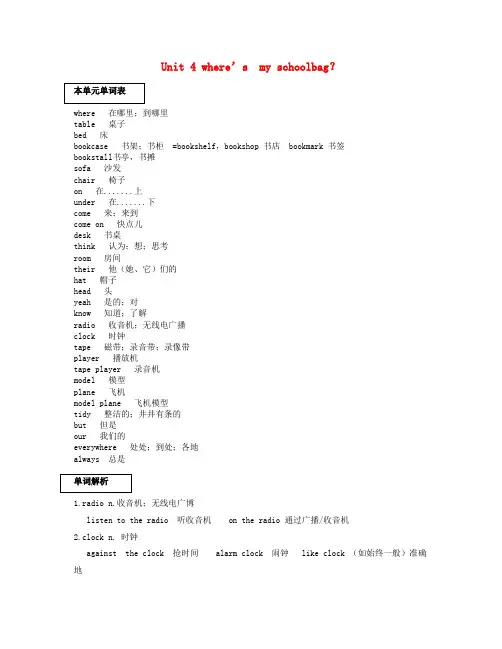
Unit 4 where’s my schoolbag?where 在哪里;到哪里table 桌子bed 床bookcase 书架;书柜 =bookshelf,bookshop 书店 bookmark 书签bookstall书亭,书摊sofa 沙发chair 椅子on 在.......上under 在.......下come 来;来到come on 快点儿desk 书桌think 认为;想;思考room 房间their 他(她、它)们的hat 帽子head 头yeah 是的;对know 知道;了解radio 收音机;无线电广播clock 时钟tape 磁带;录音带;录像带player 播放机tape player 录音机model 模型plane 飞机model plane 飞机模型tidy 整洁的;井井有条的but 但是our 我们的everywhere 处处;到处;各地always 总是1.radio n.收音机;无线电广博listen to the radio 听收音机 on the radio 通过广播/收音机2.clock n. 时钟against the clock 抢时间 alarm clock 闹钟 like clock (如始终一般)准确地o’clock ……点钟(对比clock 表示“钟表”)与watch 的辨析,见七上unit33.tape n.磁带;录音带;录像带tape player 磁带播放机 CD player CD播放机player此处意为“播放机”,为可数名词,还有运动员的意思。
4.plane 飞机model plane 飞机模型 on a plane 在飞机上catch a plane 赶飞机 by plane 乘飞机5.tidy adj.整洁的;井井有条的 v.使……保持整洁;整理;收拾untidy 不整洁的;凌乱的近义词:neat adj.整洁的 clean adj.干净的;v.打扫keep tidy 保持整洁 neat and tidy 干净整齐6.but conj.但是用于连接两个并列的成分,表示前后意义上的转折或两种情况的对比,意为“但是”。
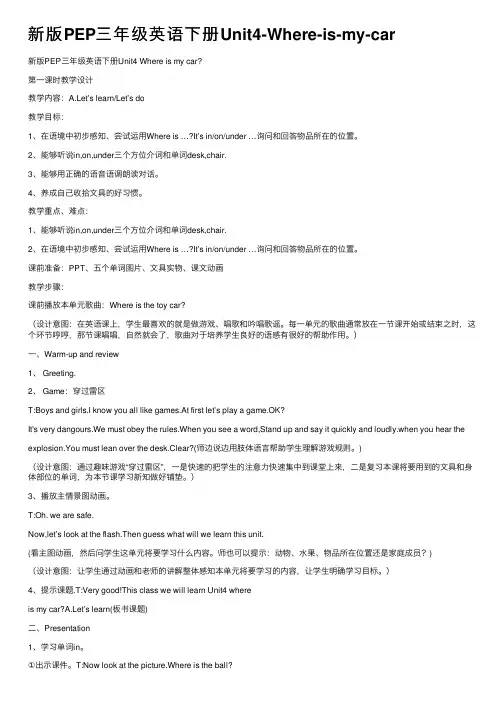
新版PEP三年级英语下册Unit4-Where-is-my-car新版PEP三年级英语下册Unit4 Where is my car?第⼀课时教学设计教学内容:A.Let’s learn/Let’s do教学⽬标:1、在语境中初步感知、尝试运⽤Where is …?It’s in/on/under …询问和回答物品所在的位置。
2、能够听说in,on,under三个⽅位介词和单词desk,chair.3、能够⽤正确的语⾳语调朗读对话。
4、养成⾃⼰收拾⽂具的好习惯。
教学重点、难点:1、能够听说in,on,under三个⽅位介词和单词desk,chair.2、在语境中初步感知、尝试运⽤Where is …?It’s in/on/under …询问和回答物品所在的位置。
课前准备:PPT、五个单词图⽚、⽂具实物、课⽂动画教学步骤:课前播放本单元歌曲:Where is the toy car?(设计意图:在英语课上,学⽣最喜欢的就是做游戏、唱歌和吟唱歌谣。
每⼀单元的歌曲通常放在⼀节课开始或结束之时,这个环节哼哼,那节课唱唱,⾃然就会了,歌曲对于培养学⽣良好的语感有很好的帮助作⽤。
)⼀、Warm-up and review1、 Greeting.2、 Game:穿过雷区T:Boys and girls.I know you all like games.At first let’s play a game.OK?It's very dangours.We must obey the rules.When you see a word,Stand up and say it quickly and loudly.when you hear the explosion.You must lean over the desk.Clear?(师边说边⽤肢体语⾔帮助学⽣理解游戏规则。
)(设计意图:通过趣味游戏“穿过雷区”,⼀是快速的把学⽣的注意⼒快速集中到课堂上来,⼆是复习本课将要⽤到的⽂具和⾝体部位的单词,为本节课学习新知做好铺垫。
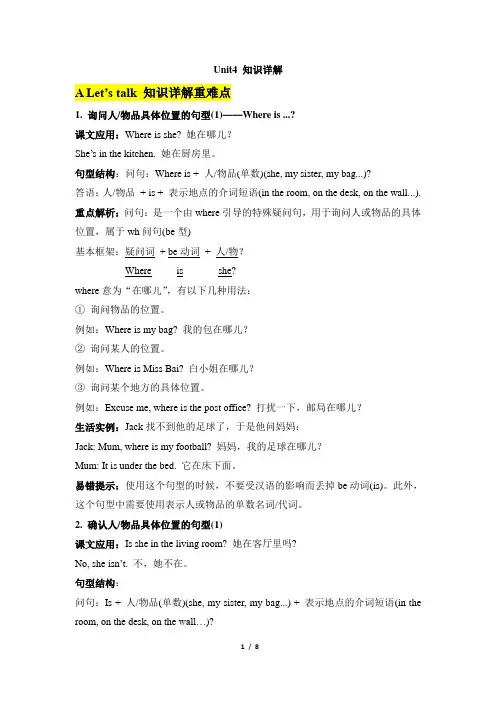
Unit4 知识详解A Let’s talk 知识详解重难点1. 询问人/物品具体位置的句型(1)——Where is ...?课文应用:Where is she? 她在哪儿?She’s in the kitchen. 她在厨房里。
句型结构:问句:Where is + 人/物品(单数)(she, my sister, my bag...)?答语:人/物品+ is + 表示地点的介词短语(in the room, on the desk, on the wall...). 重点解析:问句:是一个由where引导的特殊疑问句,用于询问人或物品的具体位置,属于wh问句(be型)基本框架:疑问词+ be动词+ 人/物?Where is she?where意为“在哪儿”,有以下几种用法:①询问物品的位置。
例如:Where is my bag? 我的包在哪儿?②询问某人的位置。
例如:Where is Miss Bai? 白小姐在哪儿?③询问某个地方的具体位置。
例如:Excuse me, where is the post office? 打扰一下,邮局在哪儿?生活实例:Jack找不到他的足球了,于是他问妈妈:Jack: Mum, where is my football? 妈妈,我的足球在哪儿?Mum: It is under the bed. 它在床下面。
易错提示:使用这个句型的时候,不要受汉语的影响而丢掉be动词(is)。
此外,这个句型中需要使用表示人或物品的单数名词/代词。
2. 确认人/物品具体位置的句型(1)课文应用:Is she in the living room? 她在客厅里吗?No, she isn’t. 不,她不在。
句型结构:问句:Is + 人/物品(单数)(she, my sister, my bag...) + 表示地点的介词短语(in the room, on the desk, on the wall…)?答语:Yes, he/she/it is. /No, he/she/it isn’t.重点解析:这个问句用于确认人或物品的具体位置,属于Be型疑问句,基本框架:Be动词+ 人/物+ 其他?Is she in the living room?我们已经在前面学习过用where来询问人或物品的具体位置,这里我们学习用is 引导的一般疑问句来确认单数的人或物品的具体位置。
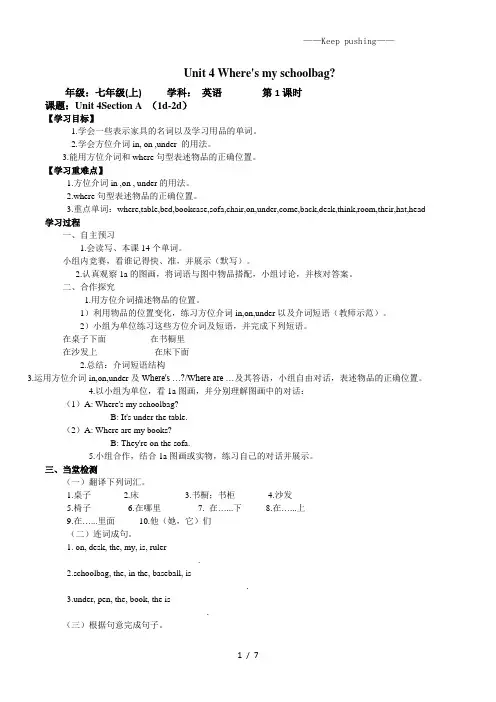
Unit 4 Where's my schoolbag?年级:七年级(上) 学科:英语第1课时课题:Unit 4Section A (1d-2d)【学习目标】1.学会一些表示家具的名词以及学习用品的单词。
2.学会方位介词in, on ,under 的用法。
3.能用方位介词和where句型表述物品的正确位置。
【学习重难点】1.方位介词in ,on , under的用法。
2.where句型表述物品的正确位置。
3.重点单词:where,table,bed,bookcase,sofa,chair,on,under,come,back,desk,think,room,their,hat,head学习过程一、自主预习1.会读写、本课14个单词。
小组内竞赛,看谁记得快、准,并展示(默写)。
2.认真观察1a的图画,将词语与图中物品搭配,小组讨论,并核对答案。
二、合作探究1.用方位介词描述物品的位置。
1)利用物品的位置变化,练习方位介词in,on,under以及介词短语(教师示范)。
2)小组为单位练习这些方位介词及短语,并完成下列短语。
在桌子下面__________在书橱里___________在沙发上____________ 在床下面____________2.总结:介词短语结构_______________________3.运用方位介词in,on,under及W here's …?/W here are …及其答语,小组自由对话,表述物品的正确位置。
4.以小组为单位,看1a图画,并分别理解图画中的对话:(1)A: Where's my schoolbag?B: It's under the table.(2)A: Where are my books?B: They're on the sofa.5.小组合作,结合1a图画或实物,练习自己的对话并展示。
三、当堂检测(一)翻译下列词汇。
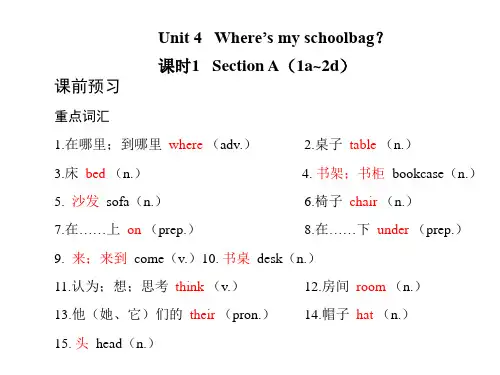
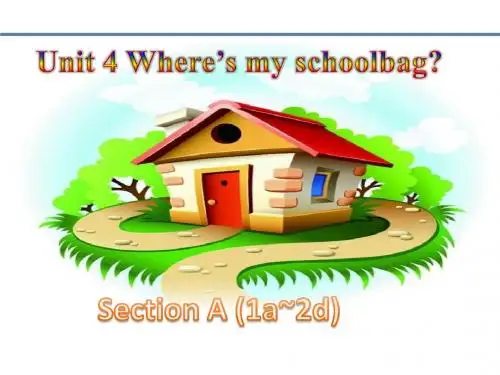
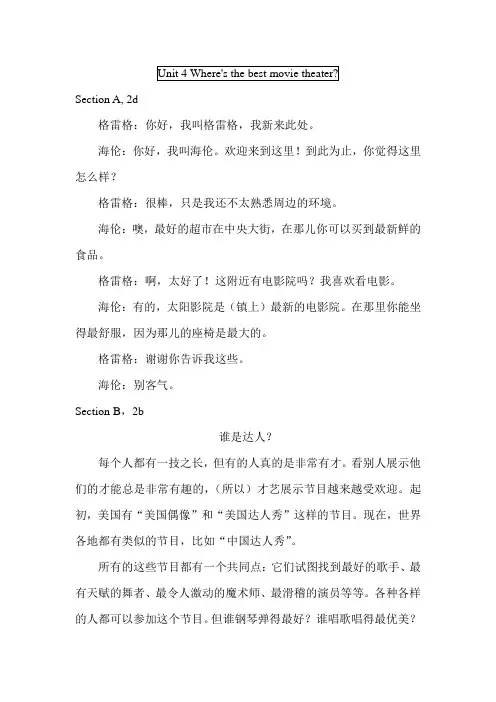
Section A, 2d
格雷格:你好,我叫格雷格,我新来此处。
海伦:你好,我叫海伦。
欢迎来到这里!到此为止,你觉得这里怎么样?
格雷格:很棒,只是我还不太熟悉周边的环境。
海伦:噢,最好的超市在中央大街,在那儿你可以买到最新鲜的食品。
格雷格:啊,太好了!这附近有电影院吗?我喜欢看电影。
海伦:有的,太阳影院是(镇上)最新的电影院。
在那里你能坐得最舒服,因为那儿的座椅是最大的。
格雷格:谢谢你告诉我这些。
海伦:别客气。
Section B,2b
谁是达人?
每个人都有一技之长,但有的人真的是非常有才。
看别人展示他们的才能总是非常有趣的,(所以)才艺展示节目越来越受欢迎。
起初,美国有“美国偶像”和“美国达人秀”这样的节目。
现在,世界各地都有类似的节目,比如“中国达人秀”。
所有的这些节目都有一个共同点:它们试图找到最好的歌手、最有天赋的舞者、最令人激动的魔术师、最滑稽的演员等等。
各种各样的人都可以参加这个节目。
但谁钢琴弹得最好?谁唱歌唱得最优美?
那由你自己来决定。
人们看这类节目的时候,通常承担着评判优胜者的角色。
而且,获胜者总是能得到丰厚的奖赏。
然而,并不是每个人都喜欢观看这些节目。
有的人认为表演者的生活是杜撰出来的。
比如就有人说自己是家境贫寒的农民,但事实上他们是演员。
但是如果你不把这些节目太当回事,它们还是有看头的。
而且有一点比较好,就是它们给人们提供了一条实现自己梦想的道路。
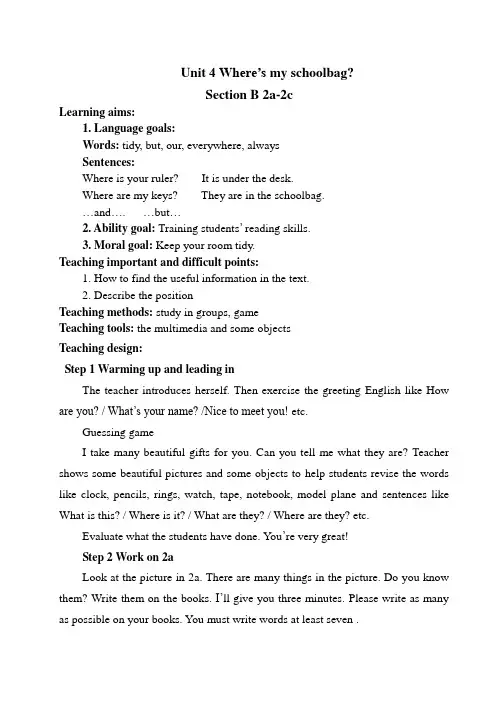
Unit 4 Where’s my schoolbag?Section B2a-2cLearning aims:1. Language goals:Words: tidy, but, our, everywhere, alwaysSentences:Where is your ruler? It is under the desk.Where are my keys? They are in the schoolbag.…and…. …but…2. Ability goal: Training students’ reading skills.3. Moral goal: Keep your room tidy.Teaching important and difficult points:1. How to find the useful information in the text.2. Describe the positionTeaching methods: study in groups, gameTeaching tools: the multimedia and some objectsTeaching design:Step 1 Warming up and leading inThe teacher introduces herself. Then exercise the greeting English like How are you? / What’s your name? /Nice to meet you! etc.Guessing gameI take many beautiful gifts for you. Can you tell me what they are? Teacher shows some beautiful pictures and some objects to help students revise the words like clock, pencils, rings, watch, tape, notebook, model plane and sentences like What is this? / Where is it? / What are they? / Where are they? etc.Evaluate what the students have done. You’re very great!Step 2 Work on 2aLook at the picture in 2a. There are many things in the picture. Do you know them? Write them on the books. I’ll give you three minutes. Please write as many as possible on your books. You must write words at least seven .Teacher goes around the classroom, give them some help.The teacher appraises the students have done in groups. Let some students show their books on the big screen. Write their marks on the blackboard.Show the reference versions with the help of the multimedia.Students read them together.Step 3 Work on 2b1. Before the new lesson let’s study some new words first.Show the new words with the help of the multimedia.tidy ['taɪdɪ]adj. 整洁的;井井有条的but [bʌt]conj. 但是our [aʊə] pron. 我们的everywhere ['evrɪweə] adv. 处处;到处always ['ɔːlweɪz] adv. 总是Teach and help students to study the words.Give students three minutes to remember the words.Check the words. Appraise what the students have done.2. Give students three minutes to read the text again. Underline the places of the circled things.Use the above methods. Teacher also shows someone’s books on the big screen with the help of the projector. Teacher adds some information about the prepositional phrase.3. Difficult sentences 难句呈现Finish the chart in 2c using the above methods.I’m Kate, and my sister is Gina. conj. 表顺承I’m tidy, but Gina is not. conj. 表转折In our room, my books and tapes are in the bookcase. conj. 表并列Gain's books are on the sofa and under the chair. conj. 表并列I have a clock. v. 有Gina always asks. v. 问(第三人称单数)Read the above sentences.4. Listen to the passage and answer the questions.1). Is Kate tidy? 2). Is Gina tidy?Teacher goes around the classroom, give some help. After stopping the player, ask students to answer the questions. The rest students evaluate what the students have done. Then teacher shows the reference versions with the help of the multimedia.5. Give students five minutes to read the passage again, answer the following questions. Show the questions with the help of the multimedia.1)A re Kate’s books and tapes in the bookcase?2)Where are Kate’s keys? 3)Is the clock under the desk?4)Where are Gina’s books? 5)Whose(谁的) model plane is it?Race (抢答)1). The main idea of the passage is about ________ .(这篇文章的中心是关于什么?)A. Kate and he r sister GinaB. Kate and Gina’s roomC. that Kate is tidy, but Gina isn’t2). Do you like Kate or Gina?Ask students if they have any questions about the passage. If they have, help them deal with them.Step 3 Read the text again for three minutes. Complete the chart about the things Kate and Gina have and where they are.Then teacher shows the reference versions with the help of the multimedia. Exercise with the information in the chart like making a dialogue or make sentences. E.g. where are Gina’s keys? They’re in the bookcase.Gina’s keys are in the bookcase.Step 4 Test英汉互译(1).under the chair _______ (2). I have a clock._______(3).in the schoolbag ______ (4).在书柜里______(5).凯特的磁带______ (6).在我们的房间里______(7).在图片里_______ (8).on his head_______Step 5 SummaryWords: tidy, but, our, everywhere, alwaysSentences:Where is your ruler? It is under the desk.Where are my keys? They are in the schoolbag.Evaluate what the students have done. Sum the marks.Homework1.Remember the new words.2. Describe your room with 3—6 sentences.Blackboard design:Unit4 where is my schoolbag?Section B 2a—2c句子prep. in on underAnd主语介词短语prep.phrases:七年级人教版上册Unit4 where is my schoolbag?Section B 2a—2c徐堡中学张晓燕。
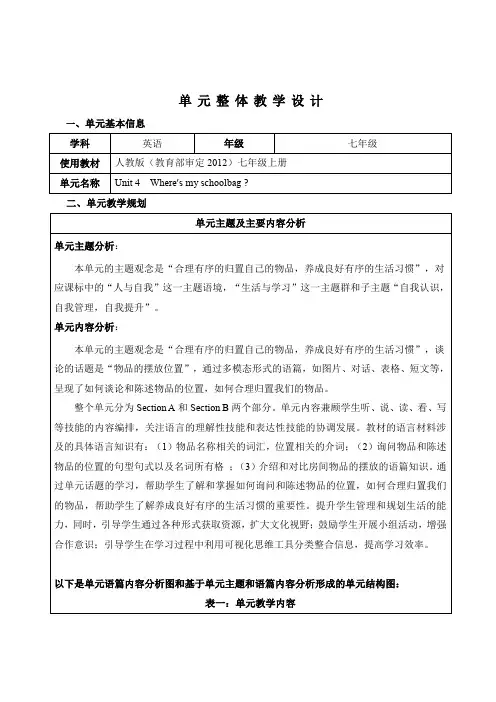
单元整体教学设计一、单元基本信息二、单元教学规划六 Section B, 2b配图小短文 内容是Kate 描述自己和自己sister 的房间物品放置情况通过2b 来学习描述自己房间物品的摆放归置情况,能够体会到整洁有序的归置物品的好处,引导学生养成有序整理和管理自己物品的好习惯,锻炼学生的观察能力,抓取细节信息,推理判断的能力。
表二:单元大观念:主题大观念小观念1:学习询问和陈述物品的位置单元大观念:合理有序的归置自己的物品,养成良好有序的生活习惯Listening &Speaking &Grammer完成Section A 1a2d ,Section A GF 3c ,Section B 1a1e ,的活动和任务,并进行对话训练,掌握学习询问和陈述物品位置的句型,掌握相关的词汇,形成小观念1。
小观念2:学习描述和对比房间里面物品的摆放情况Reading &speaking &writing完成Section B 2a3b 的阅读活动任务并学习描述你自己房间里面物品的摆放情况,形成小观念2。
核心素养的综合表现:学完本单元后,学生能够运用目标句型Where's the map? It's in your grandparents' room. Where are my books? They're on the Where's his pencil box? It's in his schoolbag.语言大观念运用询问和描述物品位置摆放的相关词汇和句型来陈述物品的位置,感受反思自己的日常生活行为,养成良好的归置物品的好习惯。
小观念1:询问物品位置的相关句型和词汇小观念2:描述和对比房间物品的摆放情况table, bed, bookcase, sofa, chair, on, under, e, desk, think, room, their, hat, head ,radio, clock, tape, player, tape player, model, planeWhere's the map? It's in your grandparents' room.Where are my books? They're on the sofa. Where's his pencil box? It's in his schoolbag.Where's your ruler? It's under the chair.Where are their keys? They're on the table.语篇结构:人物: Kate Gina 风格:Kate is tidy ,but Gina is not 物品:Kate :....Gina:...位置:....具体表达:I'm tidy,but Gina is not. In our room,my books and tapes are ... My keys are....I have a clock.It's .... Gina's books are ...。
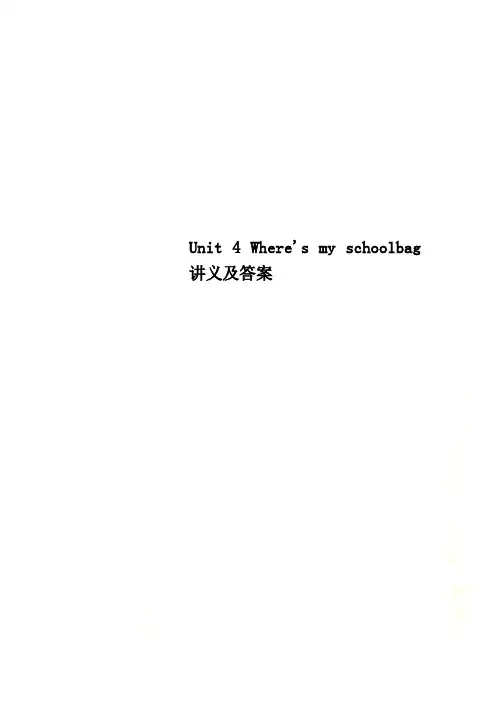
Unit 4 Where's my schoolbag 讲义及答案Unit 4 Where’s my schoolbag? Part 1 Words and Expressionswhere /w eə(r)/ adv. 在哪里;到哪里table /'teɪbl/ n. 桌子bed /bed/ n. 床bookcase /'bʊkkeɪs/ n. 书架;书柜sofa /'səʊfə/ n. 沙发chair /tʃeə(r)/ n. 椅子on /ɒn/ prep. 在……上under /'ʌndə(r)/ prep. 在……下come /kʌm/ v. 来;来到come on 快点儿desk /desk/ n. 书桌think /θɪŋk/ v. 认为;想;思考room /ruːm/ n. 房间their /ðeə(r)/ pron. 他(她、它)们的hat /hæt/ n. 帽子head /hed/ n. 头yeah /j eə/ interj. 是的;对know /nəʊ/ v. 知道;了解radio /'reɪdiəʊ/ n. 收音机;无线电广播clock /klɒk/ n. 时钟tape /teɪp/ n. 磁带;录音带;录像带player /'pleɪə(r)/ n. 播放机tape player录音机model plane /'mɒdl//pleɪn/ n.模型飞机model plane 飞机模型tidy /'taɪdi/ adj. 整洁的;井井有条的but /bʌt/ conj 但是.our /'aʊə(r)/ pron. 我们的everywhere /'evriweə(r)/ adv. 处处;到处;各个地方always /'ɔːlweɪz/ adv. 总是翻译下列句子1. 我的帽子在哪里?它在沙发上。
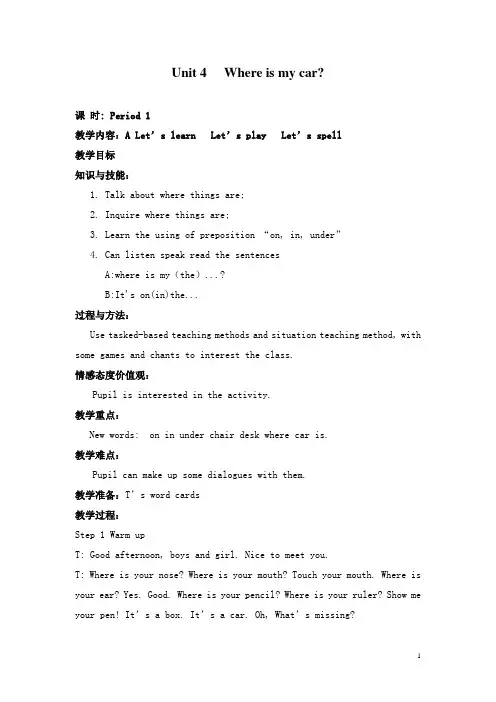
Unit 4 Where is my car?课时: Period 1教学内容:A Let’s learn Let’s play Let’s spell教学目标知识与技能:1. Talk about where things are;2. Inquire where things are;3. Learn the using of preposition “on, in, under”4. Can listen speak read the sentencesA:where is my(the)...?B:It's on(in)the...过程与方法:Use tasked-based teaching methods and situation teaching method, with some games and chants to interest the class.情感态度价值观:Pupil is interested in the activity.教学重点:New words: on in under chair desk where car is.教学难点:Pupil can make up some dialogues with them.教学准备:T’s word cards教学过程:Step 1 Warm upT: Good afternoon, boys and girl. Nice to meet you.T: Where is your nose? Where is your mouth? Touch your mouth. Where is your ear? Yes. Good. Where is your pencil? Where is your ruler? Show me your pen! It’s a box. It’s a car. Oh, What’s missing?Step2 PresentationT: My car is missing. Where is my car? (Ss read where is my car?) T: Look, look, look. Here is it! It’s on the desk. (Teach on the desk, On on on, on the desk.)Where is my car? It’s on the desk.Step3 Let’s practiceT: Where is my car? Ss: on, on, on, on the desk.T/S: Where is my pencil case? Ss: on on on, on the desk.T/S: Where is my ruler? Ss: on on on, on the pencil caseStep4 PresentationT: Where is my book? (Teacher is looking for it )T: Er-eh! Where is my book?T: On your desk?T: On your chair?T/S: Oh, look!It’s under the chair.T: Under, under (Read and show the word card un-der)Under, under, under the chair. (Ss read it )T: where is my book? Ss:under,under,under the chair.Like this teach the preposition in and toy car/ in the toy boxT: It’s a toy car. I have a toy car too. (toy car )B-oy, boy, t-oy, toy, toy, toyT:I have many toys. Toy bear. Your turn! (Ss do)Put it in the box. Toy boat, I put it in the box.T:Now, I have a toy box. (Teach toy box)It’s in the toy box.T: Toy … , It’s in the toy box.T:Take out a toy,put it on the box。
人教版PEP五班级下册学问点总结Unit4 When is the art show?一、重点单词1.四会单词first 第一second 其次third 第三fourth 第四fifth 第五twelfth 第十二twentieth 其次十twentyfirst 其次十一twentythird 其次十三thirtieth 第三十2.三会单词special 特别的fool 蠢人kitten 小猫diary 日记still 仍旧noise 噪音fur 动物皮毛open 开着的walk 行走二、短语总结special days 特别的节日art show 艺术展reading festival 读书节both of 两者都English test 英语测试swimming contest 游泳竞赛三、句型总结1. 询问有什么问:What are they?答:(They are) The school art show and the reading festival.2.询问某事在哪一天句型结构:问:When is +某事?答:It’s on+详细日期例:-When is the art show?-It’s on May 1st.3.询问某人的生日在哪一天句型结构:问:When is 某人的birthday?答:某人的birthday is on+日期例:When is your mother’s birthday?My mother’s birthday is on May 1st.4.询问将会为某人做什么句型结构:问:What will 某人do for 某人?答:某人will +动词原形for某人例:What will you do for your mother?I will cook noodles for her.四、语音学问th /ð / & /θ/1.字母组合th在数词〔包括基数词和序数词〕中读清辅音/θ/three [θriː] n. 三,三个thirty ['θɜːtɪ] n. 三十年月thirteen [θɜː'tiːn] n. 十三third [θɜːd] num. 第三fourth [fɔːθ] adj. 第四的fiftieth ['fɪftɪɪθ] num. 第五十thousand ['θaʊz(ə)nd] n. 一千hundredth ['hʌndrədθ] adj. 第一百的2.一般位于词首或词尾的th读/θ/theatre ['θɪətə] n. 电影院thin [θɪn] adj. 薄的thick [θɪk] adj. 厚的both [bəʊθ] adj. 两个的Thursday ['θɜːzdeɪ] n. 星期四path [pɑːθ] n. 道路cloth [klɒθ] n. 布;织物3.一般状况下,在代词、冠词、介词、连词或副词中的字母组合th,读浊辅音/ð/。
三年级英语下册《Unit 4 Where is my car?》教案范文五篇“老师”就应是个具有超群的德行持重明达和善的人,同时又要具有能够常常庄重安适和气地和同学交谈本事。
下面是我给大家预备的(三年级英语)下册《Unit 4 Where is my car?》教案精品(范文),供大家阅读。
三年级英语下册《Unit 4 Where is my car?》教案精品范文一学习目标:1、能够听、说、认读on, in, under, chair, desk五个单词。
2、能够在老师供应的语境中,运用这些单词来简洁询问物品的方位并作答。
3、能够在图片的关心下听懂指令并做出相应的动作,初步培育同学的空间意识。
教学重难点:重点1、能听、说、认读单词on in under chair desk。
难点1、能运用句型:Where is the?Its in/under/on the。
询问物体的位置并进行回答。
2、能依据指令将物体放在相应的位置,进而初步培育同学的空间意识。
教具预备:课件单词卡尺子铅笔文具盒等学习用具学习过程:Step 1、Warm-up1,Greeting with eath other.2,Enjoy a song .3,View A Lets talk.Step 2、PresentationTeach new words “chair desk in on under” to the students.(1) Guess:T:“Whats in your bag?你的书包里面有什么呢?Ss:......(2) 通过实物呈现单词:T:Boys and girls .Look whats this?Ss:A desk....教授单词“desk chair ”并板书。
用one by one 的方式读单词,让每个同学都能把握。
(3) 课件消失一个装着许多书的书包T:Where is my book?Ss:Its in the bag.教授单词“in”.同样(方法)教授单词“ on” “under” .运用多种方式操练单词。
Unit 4 Where’s my backpack? table 与desk的区别 table指“圆桌;饭桌”,是用餐、会谈或消遣时使用的桌子,一般不带抽屉。 desk指“书桌;课桌”,是读书、办公时使用的桌子,一般带有抽屉。
bed的固定搭配:go to bed in bed 与on the bed 的区别 in bed 表示“躺在床上”或“卧病在床”;on the bed表示“在床上” eg. Reading in bed is bad for your eyes. 躺在床上看书对你的眼睛有害。 She sees a red box on the bed. 她在床上看见一个红色的盒子。
Where’s my backpack? 本句是由where引导的特殊疑问句。where为特殊疑问词,意为“在哪里,在哪儿”,用来询问地点位置或住。基本句型为“where+be动词+名词”意为“某人/某物在哪儿? ”如果主语是人,回答时用相应的人称代词的主格形式作主语。如果主语是单数物品,回答时用“It’s+物品所在地”,如果主语是复数物品,回答时用“They are+物品所在地”。 eg.---Where is my sister? ---She is in the room.
---Where are her books? ---They’re on the desk.
---Where’s my backpack? ---It’s under the table.
I don’t know.我不知道。使用时习惯在前面加上sorry,这样语气显得更客气一些。 ---Where’s my English book? ---Sorry, I don’t know. 拓展:I don’t know.是一个否定句。句中的谓语动词是实义动词,这时,其否定形式应借助助动词do或does构成。当主语不是第三人称单数时,借助do加not(缩写为don’t)并放在谓语动词之前构成否定句;当主语是第三人称单数时,把doesn’t放在谓语动词之前,并把动词还原为动词原形构成否定句。 He doesn’t know the answer.
math作为一门学科,是不可数名词。 take与bring的区别 take拿走;带走,指从说话人所在的地方带走某人或某物。 Take the umbrella with you.你随身带上这把伞。 bring带来;拿来;取来,指把某人或某物带到说话人所在的地方。 Bring your photos to school.把你的照片带到学校来。 固定搭配:take…to…把。。。带到。。。 Please take the book to your teacher.请把这本书带给你的老师。 注意:当表示地点的词为副词here,there,home等时,介词to要省略。 Please take me home.
need表示需要。 它作实义动词时,其后可接名词代词或动词不定式作宾语,有人称和数的变化。 固定搭配:need sth需要某物 I need an eraser. need to do sth需要做某事 I need to do my homework。 拓展:need除做实义动词外,还可作情态动词,此时无人称和数的变化,其后要接动词原形并一起构成谓语,变否定句时,直接在need后加not,变疑问句时,把need提到句首。 ---Need I go home now? 我现在就需要回家吗? ---No, you needn’t. 不,你不需要。 Can you bring some things to school?这是一个以情态动词can开头的一般疑问句,用来表示请求。can能;可以;会,是情态动词的一种,不能单独做谓语,需与其后的动词原形共同构成谓语,没有人称和数的变化。当句中含有情态动词时,其疑问句形式是把情态动词提至主语之前,其否定句形式是在情态动词之后加not。 Can you help me?你可以帮助我吗? She can’t speak English.她不会说英语。 I need my hat, my notebook and a pen.本句为简单句。在英语中,当句子中出现并列成分时,无论几个,都要用逗号隔开,通常只在最后一个并列成分前加and。 I have an orange, an apple and three bananas.
介绍方位介词中的几位“嘉宾” 嘉宾一in表示“在。。。里”表示“(门、窗、钉子、洞孔等)在墙上”用in the wall,表示“(人、鸟等)在树上”in the tree. The ping-pong ball is in the box. Some boys are in the trees. 嘉宾二on表示“在。。。上”。指一件东西在另外一件东西之上,物体与物体的表面相接触。表示“(画、照片等)在墙上”用on the wall, 表示“(苹果、树叶等)在树上”用on the tree。 The ping-pong ball is on the box. Your pencil is on the desk. 嘉宾三 under表示“在。。。下面”。常指在某物的正下方,有“垂直在下”的意思,但往往不接触,其反义词为over。 The ping-pong ball is under the box. Lucy’s hat is under the chair. 嘉宾四 between表示“在(两者)之间”。常用词组为between。。。and。。。(在。。。和。。。之间) The ping-pong is between the two boxes. Is the TV between the bed and the sofa?电视在床和沙发之间吗? 嘉宾五 next to意为“贴近;靠近”,to是介词,后面接名词或宾格代词。 The ping-pong ball ia next to the box.乒乓球挨着盒子 Tom is next to me.汤姆挨着我。 注意:in 的用法总结 (1)表示方位“在。。。。里面/上”。此时要注意它与以下名词连用时的含义: 1.in the tree在树上,表示外来事物在树上停留;表示树本身长出来的东西在树上用on the tree。 2.in the picture、newspaper在图片/报纸上,表示图片或报纸上的内容。 (2)表示时间,用在表示年,月或早上,下午,晚上等时间的名词前。 in 2008 in the morning (3)表示地点,用在表示大地方(国家,城市等)的名词前 in china in Wuhan (4)表示方式,其后接声音,语言之类的名词。 in English (5)表示穿着,其后可直接接颜色或衣着类的词。 The girl in red is Lucy.
Exercise Ⅰ单项选择
1._______is your grandpa,Emma? He’s in the garden. A. When B. What C. Where D. How 2.His basketballis _______the bag. A. with B. in C. after D. of 3. Where is Wuhan? It’s_______ China. A. in B. in the C. on D. on the 4. My pen is _______my pencil case. A. of B. to C. at D. in 5. Please put your T-shirt_____ the desk. A. on B. to C. at D. of 6. His basketball is _______the chair. A. in B. under C. after D. of 7. Where are her_______? ______are on the table. A. key, It B. keys, They C. keys,It D. key,They 8. Where_____your videotapes? On the floor. A. is B. am C. are D. be 9. Here ______a photo of my family. A. is B. am C. are D. be 10. What color is________ orange? It’s______ orange. A. an,/ B.. an,the C.the, the D.the,an 11._______on the wall? No, it isn’t. A. What’s B.Her picture is C. Is his picture D. Is picture 12. Please _______ the apples to your cousin. A. take B.be C. has D.have 13. Lily is a new student. Please look after________. A. him B. her C. she D. his 14. Can you bring your homework ______school? A. to B. on C. in D. under 15. How old is ________father? A. kate B. he C. she D. kate’s 16. There are some windows_______the wall. A. on B. in C.under D. of 17. ______that? It’s my friend, Jenny. A. What’s B. Who’s C. Where’s D. How’s 18. Where’s the cat? It’s_______the chair and the sofa. A. in B. at C. over D. between 19. Thanks _______your help. A. at B. for C. in D. of 20. A kite is on _______wall. Is it _______jake’s kite? A. a,the B. the,a C.the,the D. the,/